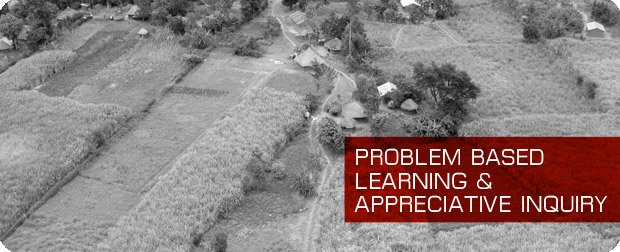Problem-Based Learning
Problem-based learning (PBL) is often used in university professional programs such as medicine and engineering where professors present case studies that challenge students to problem-solve beyond the textbook. PBL practitioners claim that their students can retain more of the course content when it is applied to relevant case studies and PBL “encourages student autonomy in analyzing cases” (Searight & Searight, 2009, p.1). Gradually the instructor’s becomes less relevant to the classroom process as the students take “responsibility for their learning…and address four dimensions of [learning]: What they know, what they want to know, possible causal hypotheses, and questions that can be answered through library research” (ibid).
Appreciative Inquiry
AI draws on Asset-Based Community Development theory that employs “asset mapping…to compile an inventory of individual and community strengths upon which a partnership could be established” (ibid). Asset-based community development begins with the assumption that successful community building involves rediscovering and mobilizing resources already present in any community:
- The skills and resources of its individuals.
- The power of voluntary associations, achieved through building relationships.
- The assets present in the array of local institutions, the physical infrastructure of the community and the local economy.
Another way of saying this is: successful community development is asset-based, internally-focused, and relationship-driven. Although some resources from outside the community are often needed, the key to lasting solutions comes from within. The gifts and skills of residents and the assets of the physical community are always the starting place.
Appreciated Inquiry is a facilitated approach that asks, “What is working well and how do we build on it?” It focuses on doing more of what is already working, rather than focusing on fixing problems. It mobilizes strategic change by focusing on core strengths, then using those strengths to reshape the future:
AI involves, in a central way, the art and practice of asking questions that strengthen a system’s capacity to apprehend, anticipate, and heighten positive potential…AI seeks, fundamentally, to build a constructive union between a whole people and the massive entirety of what people talk about as past and present capacities: achievements, assets, unexplored potentials, innovations, strengths, elevated thoughts, opportunities, benchmarks, high point moments, lived values, traditions, strategic competencies, stories, expressions of wisdom, insights into the deeper corporate spirit or soul– and visions of valued and possible futures.
(Cooperider, Sorenson, Whitney, & Yager, 2004)
The conversation with the international community partner, using an AI model, becomes a conversation about what’s working and why it’s working in their context and what might the faculty member and students bring as a service to developing their vision. As a UBC professor who practices AI says, “you don’t go in with this sort of bag of clinical or pedagogical tricks under your arm that you want to share in some magnanimous fashion, as much as you want to…you go in knowing that basically something is working so then try and work with the community to figure why that’s working and what do you need more of for that to be even more successful.”
